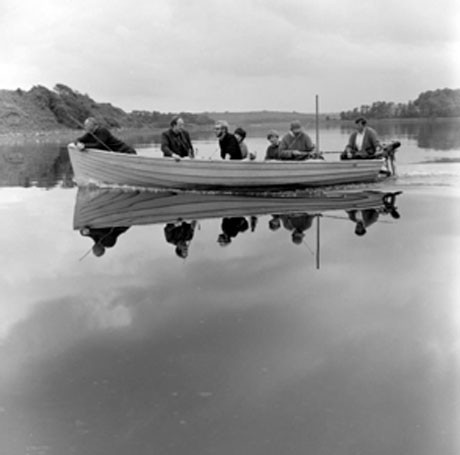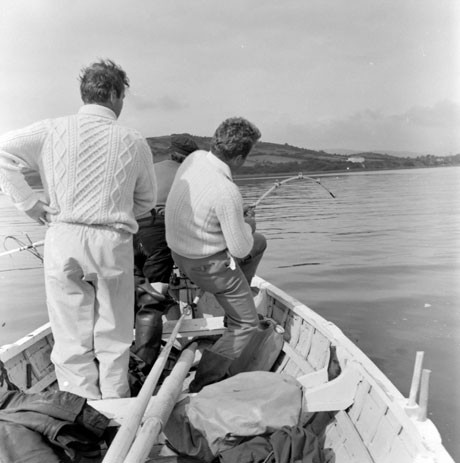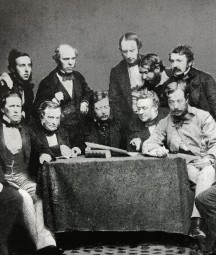By Grace Kiernan, DIT NPA Internship, Sept-Dec 2013
In September 2013 I was offered the opportunity to do an internship as part of DIT's Archiving in Context third year, semester-long module, which is run in conjunction with the National Photographic Archive (NPA). I was keen to put what I had learned about the more theoretical aspects of photographic archiving during my second year into practice by working with the NPA.
The introduction to the internship began with a meeting between Elizabeth Kirwan, Curator at the NPA and NPA Project Supervisor, Matthew Cains, Conservator at the NLI, and Keith Murphy, NPA Reading Room Supervisor. I chose to work on the Denis Tynan Collection, which consists of 1,334 black and white negatives and 127 glass plate negatives from 1950-1989. After training in basic photographic preservation, we agreed the project work: the appraisal and re-housing of the Tynan Collection; the listing of the Collection; and finally the input of that data into Virtua, the National Library’s Library Management System.

Fishing in Donegal Bay / Denis Tynan (1971)
The photographer, Denis Tynan (1923-2010), was from Abbeyleix Co Laois but moved to Donegal in 1949. His work covers from 1950 to 1989, and pertains to the everyday lives of the people of Co Donegal, predominantly in the area around the Glenties and Killybegs. Three years after moving to the Glenties, Tynan and his wife Sarah Ward, took over management of St Dominic’s Hall and cinema where they also ran a successful commercial photography business. The Tynan photography company originally focused on weddings, First Communions, Confirmations and class photographs for local schools. Their solid reputation eventually guaranteed them business and corporate clients – evidence of which can be seen within the collection.
What was of particular interest was Tynan’s documentation of the fishing industry in Donegal. These photographs appear to be a mixture of both commissioned and personal works – the most consistent subject matter being photographs of fishermen and fishing competitions, covered in a range of modes from formal portraits of the fishermen and women posing with trophies or their catch, to photographs of fishing and competitions underway. Additionally, a large portion of the collection is dedicated to local events – from sport to religious processions – providing an excellent insight into social rites in Irish rural society during that time.

From the Denis Tynan Collection
I discovered an online newsletter for the Glenties region in County Donegal which had published Denis Tynan’s obituary in 2010. I then contacted a niece of Tynan, Bridie Boyce, to learn more about her uncle and the collection. Tynan’s work on the fishing industry and fishing culture had been undertaken due to his own singular interest in that community in Donegal.
I worked on an album of negatives and a box of negatives ‘organised’ into small cardboard negative sleeves. There was a single sheet of information accompanying the items. I inspected each negative individually and compiled an initial index with a description of the contents of each cardboard and Mylar sleeve: the number of individual negatives per sheet or sleeve, the content of each individual negative and any accompanying information. This assisted in the organisation of the negatives when rehousing them.
Most of the information on the individual cardboard sleeves holding the loose negatives lists dates, place names and subjects but is handwritten and often difficult to decipher. These sleeves were sourced from the company Quirke Lynch Ltd., a photographic processing lab in Dublin established in 1978. I contacted the company owners but they had no records of past customers. Tynan was known for his “various experimentations with various methods in developing photographic negatives”.
I established that 37 out of the 67 cardboard sleeves had what appears to be code written on them, such as ‘FW(2)’, ‘GQ(2)’ and ‘HR’. The information there regarding place names, subject matter etc., matched the information on specific negatives, leading me to conclude that this information was written by Tynan himself. However, the handwriting of the ‘code’ was different. Most of these sleeves had “By D. Tynan, Glenties Co. Donegal, For All Photographic Work” stamped on them which suggested that the cardboard holders that had been used to hold the negatives preceded the collection’s accession into the NPA.
Six groups of negatives displayed blue stains and orange spotting, but the negatives which had already been housed in Mylar sleeves had not been affected. I alerted Elizabeth Kirwan to this, and NLI Conservator Matthew Cains tested for the presence of Vinegar Syndrome. Vinegar Syndrome occurs within Cellulose Acetate Film, or ‘Safety Film’, which was produced in the 20th Century to replace unstable and flammable nitrate film. Vinegar Syndrome is the decomposition of the acetate film, accelerated by historically poor storage conditions. The acetate film turns blue or pink, cracks, and secretes acetic acid (vinegar) that dissolves the film entirely. The process is rendered dormant by freezing the acetates. Fortunately, the staining was not a case of Vinegar Syndrome and the discolouration seems to be chemical staining arising from Tynan’s photographic processing practices.
A number of the negatives and a small glass plate negative, which I discovered amongst the cardboard sleeves, required rehousing in custom-made containers, made by Matthew Cains. The cardboard sleeves that had been storing the loose negatives were transferred to a separate housing.
The opportunity to work with professional archivists and conservators at the NPA in addition to being able concentrate on a hands-on project and undertake related research while learning preservation skills was an invaluable experience for me.

